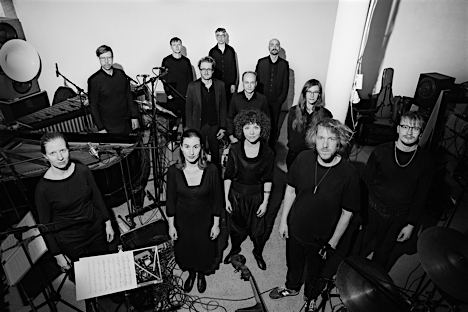Unter dem Titel “The Buchla Suite – A Handcrafted Tribute To Morton Subotnick” bringt der in Bern lebende Pianist und Komponist Stefan Schultze zusammen mit einem elfköpfigen Ensemble ein zwei CDs umfassendes “handgemachtes” Tributealbum für Morton Subotnicks Arbeiten mit dem von Donald Buchla entwickelten modularen Synthesizer heraus – handgemacht in sofern, dass die Neuinterpretationen ganz auf Synthies verzichten und die Arbeiten Subotnicks mit einem klassischen Jazz-Instrumentarium interpretieren. Beteiligt sind neben Schultze Leonhard Huen (Altsaxophon, Klarinette), Peter Ehwald (Tenor- und Sopransaxophon), Magnus Schriefl (Trompete), Elena Kakaliagou (Horn), Almut Kühne (Stimme), Roland Neffe (Marimba, Percussion), Shiau-Shiuan Hung (Vibraphon, Percussion), Peter Meer (E-Gitarre), Felix Henkelhausen (Kontrabass) und Tom Rainey (Drums). Das Album erscheint über das Label der Jazzwerkstatt.
“Squaring the circle may be an impossibility in mathematics, but it certainly works in music. At least that is what the Stefan Schultze Large Ensemble proves with the double CD The Buchla Suite – A Handcrafted Tribute To Morton Subotnick. The American composer Morton Subotnick worked together with the physicist and instrument maker Donald Buchla in San Francisco from 1963 on. With the modular synthesizer named after Buchla, he recorded the album Silver Apples To The Moon in 1967, which is still unmatched in its sonic and structural complexity. In its homage to Subotnick, the Stefan Schultze Large Ensemble does completely without synthesizers. Stefan Schultze is a pianist and producer, but first and foremost a composer. Like Subotnick, he is also a sound inventor himself. All parts of the Buchla Suite were penned by him. “The challenge is to set up the ensemble like ten oscillators,” Schultze says. “We try to sound like a synthesizer.“
Morton Subotnick’s Silver Apples is both inspiration and starting point for this. For Schultze, it was important to do justice to Subotnick’s inspiration while still remaining true to the ensemble’s identity. He himself calls his approach a commentary. During this two-year process of creation, Morton Subotnick himself also came into play. There were several meetings between the two composers, during which, for Schultze, the human factor came into play above all. He calls this human transformation process one of the most fascinating moments in his work. Subotnick primarily communicated directly with his device, but Schultze translates this into a context with many individual voices and understands the Large Ensemble in this project as a social synthesizer. Unconditional genuine creation as a primordial human impulse – nothing else happens on The Buchla Suite – A Handcrafted Tribute To Morton Subotnick. Setting out in the known, not losing sight of one’s vision, knowing that one will arrive, but without being able to predict where exactly that will be”. (Wolf Kampmann)
Foto © Dovile Sermokas

